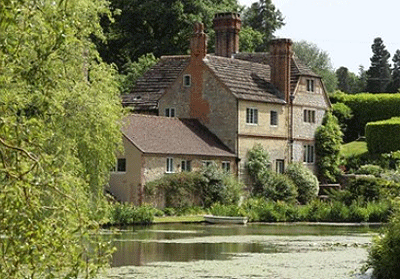A Poet, an Archbishop, and a Prime Minister's Wife
The history of West Wantley includes well known names including the poet Shelley and Clementine Churchill

The Grade II* listed West Wantley, on the market with Chesterton Humberts, dates back to the medieval period, with a number of extraordinary period features, including an inglenook fireplace, exposed oak beams and casement windows. However, along with its retained period features, West Wantley also has a number of connections with historic characters, most notably Clementine Churchill, wife of Sir Winston Churchill, and romantic poet, Percy Bysshe Shelley.
West Wantley has been traced back to the 15th century, although, it is possible the core of the house was constructed as early as the 14th century. Early records show that Roger Wantley conveyed the property to John Bartlett and by 1448 the ‘lands, tenements, rents and services in Sullington and Storrington called West Wantele' were granted to Thomas Bartelot [sic], son of John Bartelot. As the years went by, West Wantley and the estate passed through to a number of occupants, and by 1633 had been purchased by George Abbot, Archbishop of Canterbury. However, within the year he had passed away and the house passed to his nephew, Richard Abbot.
In 1641, Richard Abbot sold West Wantley to Gregory Haines and by 1654 it had passed to his son, Richard. It was at this time that Richard Haines instigated a large rebuilding and renovating of the house. A date plaque above the entrance porch records the date, ‘1656' and the initials ‘R H M' for Richard and Mary Haines. Richard Haines was not only responsible for much of the rebuilding of West Wantley, but he was a noted writer, philanthropist and inventor. He wrote a number of books, including The Prevention of Poverty (1674) and A Model Government (1678) and was responsible for a number of patents for inventions, including a spinning engine in 1678.
Richard and Mary Haines lived at West Wantley for 30 years, but by 1691 his son had sold the house and estate to Edward Shelley. It passed to a number of members of the Shelley family into the 18th century, by which time the house was leased to tenants, the Harraden family. By the 1780s, land tax records show that the owner of West Wantley was John Shelley and the house was occupied by Richard Harraden.

* Subscribe to Country Life and save 30%
By 1795, West Wantley was owned by Sir Bysshe Shelley, 1st baronet of Castle Goring. In 1815, Sir Bysshe Shelley passed away and the estate passed to his eldest son, Sir Timothy Shelley, 2nd baronet, and father of the renowned romantic poet, Percy Bysshe Shelley. However, by this time, Shelley was 25 and had already written a number of books, as well as been married and run off to Switzerland with the writer, Mary Wollstonecraft. He died only a few years later, in 1822, in a boating accident in Italy. When Sir Timothy died in 1844, the baronetcy and estate passed to the son of the poet Shelley and Mary Wollstonecraft, Percy Florence Shelly. Meanwhile, West Wantley was occupied by various tenants and by the 1830s had become the home of the Skinner family.
The census records show that through the 1850s and 60s ‘West Wantley Farm' continued as the home of members of the Skinner family. However, by the 1890s the house had become the home of Cecil and Mary Paget and it was during this time that Mary Paget would often invite the young Clementine Hozier, the future wife of Prime Minister, Sir Winston Churchill, to stay. Clementine was the second daughter of Sir Henry Montague Hozier and Lady Henrietta Blanche Hozier. It is believed she visited West Wantley a number of times, before she travelled to Europe with her family as a teenager. Clementine married Winston Churchill in 1908.
Exquisite houses, the beauty of Nature, and how to get the most from your life, straight to your inbox.
In 1921, West Wantley was placed on the market as part of the Fryern estate, at which time it was described as ‘A valuable freehold pleasure farm' and ‘an extremely interesting ancient farmhouse chiefly constructed of stone...very pleasantly situate in rural surroundings with capital vegetable and pleasure gardens attached.'
Today, West Wantley still retains exceptional historic features, including wood panelling, oak front door and along with the date plaque over the entrance porch there is also a lead drain head featuring the date 1656. The inglenook fireplace also features a cupboard for salt, a seat, and high up within the chimney is a recess for curing bacon, believed to be so large a man can lie full length in it.
* More details on West Wantley
* To read the full history visit my blog - The House Historian
Country Life is unlike any other magazine: the only glossy weekly on the newsstand and the only magazine that has been guest-edited by His Majesty The King not once, but twice. It is a celebration of modern rural life and all its diverse joys and pleasures — that was first published in Queen Victoria's Diamond Jubilee year. Our eclectic mixture of witty and informative content — from the most up-to-date property news and commentary and a coveted glimpse inside some of the UK's best houses and gardens, to gardening, the arts and interior design, written by experts in their field — still cannot be found in print or online, anywhere else.

